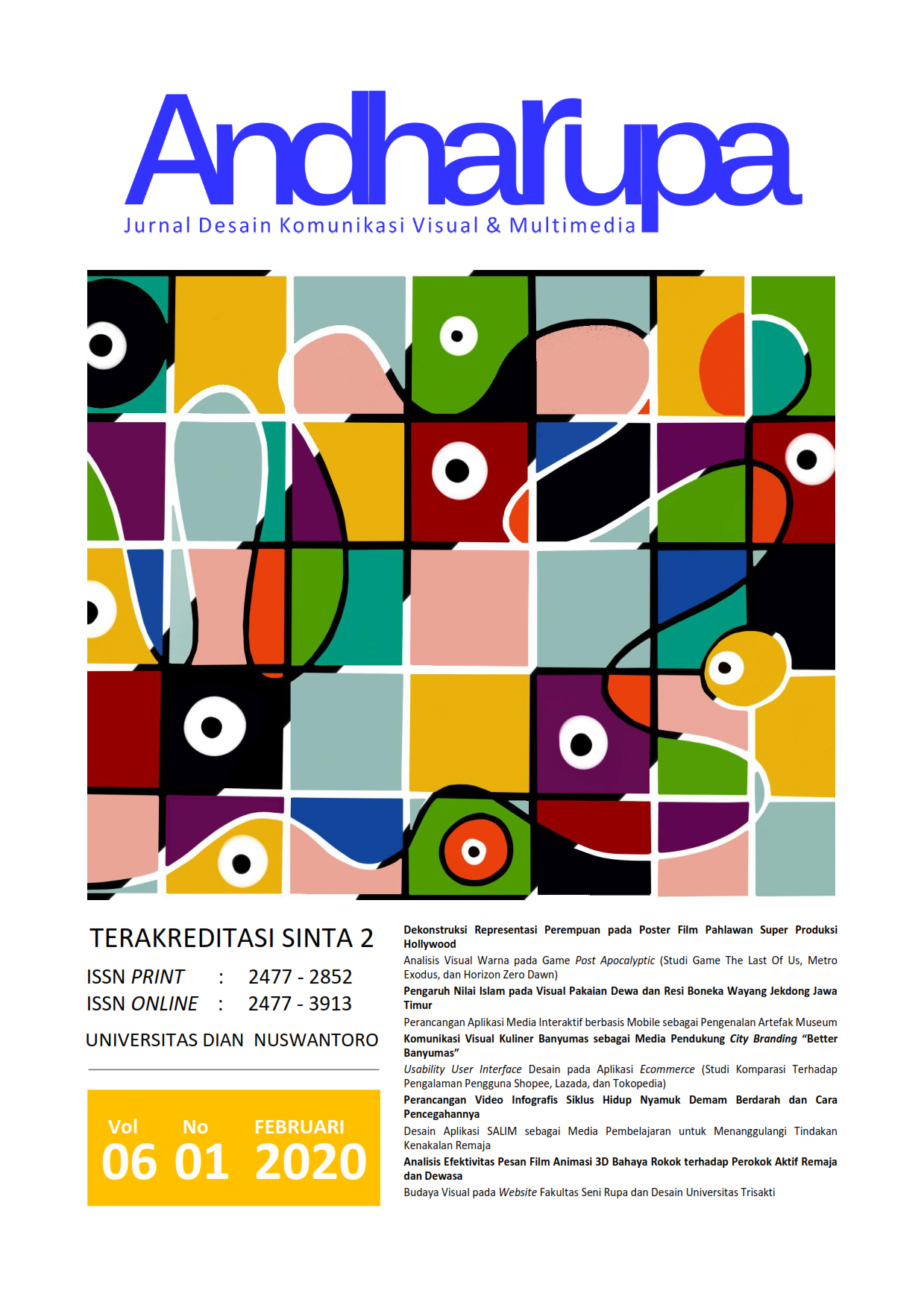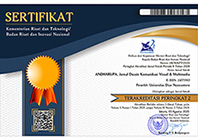Perancangan Aplikasi Media Interaktif berbasis Mobile sebagai Pengenalan Artefak Museum
DOI:
https://doi.org/10.33633/andharupa.v6i1.2794Abstract
AbstrakMuseum merupakan tempat untuk melihat informasi, koleksi benda, dan peristiwa-peristiwa dari masa lalu. Museum Panca Yadnya menjadi salah satu museum yang menyimpan artefak kebudayaan di Bali. Saat ini museum tidak dibuka untuk umum karena masih minimnya petugas yang berjaga. Sehingga perlu adanya akses informasi bagi masyarakat umum agar mengetahui koleksi artefak yang ada di museum mengingat pentingnya nilai artefak yang dimiliki museum Panca Yadnya. Melalui pemanfaatan teknologi dengan perancangan aplikasi media interaktif, informasi tentang museum dan koleksinya tetap dapat diakses oleh masyarakat dengan lebih mudah dan lebih menyenangkan. Pembuatan aplikasi dilakukan menggunakan Construct 2 dan dirancang menggunakan metode pengembangan multimedia Luther-Sutopo dengan tambahan tahap maintenance. Aplikasi dibuat dalam bentuk media interaktif yang berguna untuk menampilkan dan memberikan penjelasan tentang informasi dari koleksi yang terdapat pada museum dengan lisan maupun tulisan melalui smartphone. Sampai dengan tahap akhir, aplikasi dapat berjalan dengan baik dan mampu memberikan informasi sesuai dengan yang diharapkan. Kata Kunci: aplikasi, artefak, media interaktif, museum AbstractA museum is a place to see a piece of information, a collection of valuable objects,  and past events. The Panca Yadnya Museum is one of the museums that store cultural artifacts in Bali. At the moment, the museum is not open to the public due to the lack of officers on duty, so it needs information access to the public so that the public could recognize the artifact collection on the museum, considering the important value of the artifact owned by the Panca Yadnya museum. By utilization technology with design application interactive media, information about the museum and the collection could still be accessed by the public more easily and more enjoyable. The build of an application is done by using Construct 2 and designed using the multimedia Luther-Sutopo method with the additional maintenance step. Application is made in the form of interactive media that is useful for displaying and providing explanations about information from collections that were contained in the museum using verbal nor writing via smartphone. Until the final step, the application can run well and be able to provide information as expected.  Keywords: application, artifact, interactive media, museumReferences
Andriyanto, I. (2016). Game Edukasi Pengenalan Rambu-Rambu Lalu Lintas Untuk Anak SD. Surakarta: Universitas Muhammadiyah Surakarta.
Arifin, J., & Fadhlillah, M. R. (2017). Multimedia Interaktif Sebagai Media Informasi Mengenai Pengenalan Energi Alternatif. JESKOVSIA (Jurnal Desain Komunikasi Visual Asia), 1(1), 30–43.
Badan Pusat Statistik Provinsi Bali. (2019). Kunjungan Wisatawan Domestik ke Bali per Bulan 2004-2018. Retrieved July 30, 2019, from https://bali.bps.go.id/statictable/2018/02/09/29/kunjungan-wisatawan-domestik-ke-bali-per-bulan-2004-2017.html
Badan Pusat Statistik Provinsi Bali. (2019b). Proyeksi Penduduk Provinsi Bali Menurut Kabupaten/Kota dan Jenis Kelamin, 2011-2020. Retrieved July 30, 2019, from https://bali.bps.go.id/dynamictable/2016/05/13/19/proyeksi-penduduk-provinsi-bali-menurut-kabupaten-kota-dan-jenis-kelamin-2011-2020.html
Banindro, B. S. (2019). Pengembangan Techno Virtual Berbasis Website sebagai Media Pembelajaran Rekayasa Visual Blender 3D bagi Mahasiswa Desain Produk. ANDHARUPA: Jurnal Desain Komunikasi Visual & Multimedia, 5(01), 102–114.
Junaidi. (2010). Tabel r - Prima-Pens. Retrieved July 30, 2019, from prima.lecturer.pens.ac.id/Pasca/tabel_r.pdf
Komala, R. D., & Nellyaningsih. (2017). Tinjauan Implementasi Personal Selling Pada PT. Astra Internasional Daihatsu Astra Biz Center Bandung Pada Tahun 2017. Fakultas Ilmu Terapan Universitas Telkom, 3(2), 330–337.
Kusmanagara, Y., Marisa, F., & Wijaya, I. D. (2018). Membangun Aplikasi Multimedia Interaktif Dengan Model Tutorial Sebagai Sarana Pembelajaran Bahasa Kanton. JIMP - Jurnal Informatika Merdeka Pasuruan, 3(2), 1–8.
LIPI. (2017). Jumlah pengunjung Kebun Raya LIPI tahun 2014-2017. Retrieved January 18, 2019, from http://krbogor.lipi.go.id/id/download/unduh_berkas/72.html
LIPI, H. (2018). Kebun Raya Bali LIPI Buka Museum dan Taman PancaYadnya. Retrieved January 19, 2019, from http://lipi.go.id/berita/single/Kebun-Raya-Bali-LIPI-Buka-Museum-dan-Taman-PancaYadnya/20901
Maharani, P. (2018). Pengembangan Multimedia Pembelajaran Interaktif Menggunakan Construct 2 Tentang Suhu Dan Kalor Untuk Siswa Kelas X SMA. Lampung: Universitas Islam Negeri Raden Intan Lampung.
Nuryati. (2015). Pengaruh Komunikasi Sekolah Dengan Orang Tua Dan Peran Orang Tua Siswa Terhadap Hasil Belajar Muatan Matematika Semester Gasal Pada Kelas Rendah Di SD Negeri 1 Jagoan Tahun Pelajaran 2014/2015. Suarakarta: Universitas Muhammadiyah Surakarta.
Purnama, I. N., & Ardyanti, A. A. A. P. (2017). Peramalan Kunjungan Wisatawan Di Obyek Wisata Bedugul Menggunakan Algoritma Fuzzy Time Series. SMARTICS Journal, 3(2), 55–58.
Untoro, W. (2019). Pengembangan Metode Luther-Sutopo Dalam Pembuatan Game Edukasi Bedugul Forest. Denpasar: STMIK Primakara.
Zaharnita, E., Witarsa, & Rosyid, R. (2016). Pemanfaatan Internet Sebagai Sumber Informasi Belajar Pada Mahasiswa Pendidikan Ekonomi Universitas Tanjungpura. Pendidikan Dan Pembelajaran, 5(9), 1–17.
Downloads
Published
Issue
Section
License
Copyright (c) 2020 ANDHARUPA: Jurnal Desain Komunikasi Visual & Multimedia

This work is licensed under a Creative Commons Attribution 4.0 International License.
Authors who publish with this journal agree to the following terms:
- Authors retain copyright and grant the journal right of first publication with the work simultaneously licensed under a Creative Commons Attribution License that allows others to share the work with an acknowledgment of the work's authorship and initial publication in this journal.
- Authors are able to enter into separate, additional contractual arrangements for the non-exclusive distribution of the journal's published version of the work (e.g., post it to an institutional repository or publish it in a book), with an acknowledgment of its initial publication in this journal.
- Authors are permitted and encouraged to post their work online (e.g., in institutional repositories or on their website) prior to and during the submission process, as it can lead to productive exchanges, as well as earlier and greater citation of published work (See The Effect of Open Access).















